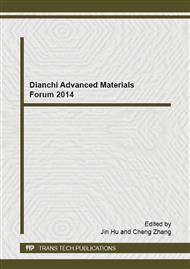[1]
Ohashi Fumihiko, Maeda Masaki, Inukai Keiichi, et al, Study on intelligent humidity control materials: water vapor adsorption properties of mesostructured silica derived from amorphous fumed silica, Journal of Materials Science Letters, vol. 34(1999).
Google Scholar
[2]
Zhang Huibo, HiroshiYoshino, Analysis of indoor humidity environment Chinese residential buildings, Building and Environment, Vol. 45(2010), pp.2132-2140.
DOI: 10.1016/j.buildenv.2010.03.011
Google Scholar
[3]
Anthony V. Arundel, Elia M. Sterling, Judith H. Biggin, et al, Indirect health effects of relative humidity in indoor environments, Environmental Health Perspectives, vol. 65(1986), pp. 35l-361.
DOI: 10.2307/3430203
Google Scholar
[4]
Tomita Yumiko, Takahashi Ryoji, Sato Satoshi, et al, Humidity control ability of silica with bimodal pore structures prepared from water glass, Journal of the Ceramic Society of Japan, vol. 112(2004), p.491–495.
DOI: 10.2109/jcersj.112.491
Google Scholar
[5]
Lv Rongchao, Ji Zhijiang, Zahng Liansong, et al, The application of sepiolite as humidity controlling materials, Acta Petrologica Et Mineralogica, vol. 4(2005), pp.329-332(In Chinese).
Google Scholar
[6]
Jiang Hongyi, Luan Congmei, Pore structure and humidity controlling capabilities activated sepiolite powder, Journal of Wuhan University of Technology, vol. 5(2010), pp.9-11(In Chinese).
Google Scholar
[7]
Chen Zuoyi, Application and research review of humidity-controlling materials for building energy conservation, New Chemical Materials, vol. 7(2010), pp.20-22(In Chinese).
Google Scholar
[8]
Li Zhi, Cheng xiaosu, Zeng Lingke, et al, Main factors affecting humidity controlling performance, China Ceramic Industry, vol. 1(2014), pp.28-32(In Chinese).
Google Scholar
[9]
Jiang Hongyi, Wang yipping, Wan Weixin. Research of pore-structure and humidity control performance about zeolite and diatomite, Bulletin of the Chinese Ceramic Society, vol. 6(2006), pp.30-33(In Chinese).
Google Scholar
[10]
Jia Yuxin, Han Wei, Xiong Guoxing, et al, Diatomite as high performance and environment friendly catalysis for phenol hydroxylation with H2O2, Science and Technology of Advanced Materials, vol. 8(2007), pp.106-109(In Chinese).
DOI: 10.1016/j.stam.2006.10.003
Google Scholar
[11]
Kong Wei, Du Yucheng, Bu Cangyou, et al, Study on preparation and performance of diatomite-based humidity controlling materials, Non-Metallic Mines, vol. 1(2011), pp.57-59+62(In Chinese).
Google Scholar
[12]
Ran Maoyu, Review of research and application of air humidity controlling materials in Japan, Materials Review, vol. 11(2002), pp.42-44(In Chinese).
Google Scholar
[13]
Dinh-Hieu Vu, Kuen-Sheng Wang, Bui Hoang Bac, Bui Xuan Nam. Humidity control materials prepared from diatomite and volcanic ash, Construction and Building Materials, vol. 38(2013), pp.1066-1072.
DOI: 10.1016/j.conbuildmat.2012.09.040
Google Scholar
[14]
Dinh-Hieu Vu, Kuen-Sheng Wang, Bui Xuan Nam, et al, Preparation of humidity-controlling porous ceramics from volcanic ash and waste glass, Ceramics International, vol. 37(2011), pp.2845-2853.
DOI: 10.1016/j.ceramint.2011.04.118
Google Scholar
[15]
JC/T2002-2009, Testing for water vapor adsorption/desorption performance of building materials.
Google Scholar
[16]
Yang Yuxiang, Chen Rongsan, Dai Anbang, A study on Structure of Local Diatomites, Acta Chimica Sinica, vol. 1(1996), pp.57-64(In Chinese).
Google Scholar


